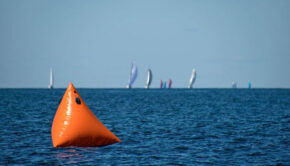Pros and Cons for Pros in Sailing
Published on February 14th, 2024
Success in any sport requires an investment of time and money, but participation is a measure of how far apart people are willing to invest. Don Finkle with RCR Yachts discusses a dominant cost variable in sailing:
You will find strong opinions on both sides of this discussion, and I admit to being conflicted. Traditionally professionals in our sport were largely those who worked in the industry in some capacity and also sailed when they could; not much different from the rest of us when it came to time on the water. They were employees first and sailors second, but that is not always the case.
Today, there are full time professionals who get paid to race with customers as hired guns. In the most competitive one design classes, the boats with pros aboard greatly outnumber the teams with no pros, often called Corinthian teams.
The caliber of racing in these fleets is very high, and as a result new ways of tuning, sail design and the ways the boat are sailed continue to evolve. What is wrong with that? Well, depending on your viewpoint, we can think of several things.
Let’s agree that as an amateur, being on the same starting line and course as the best in the world is a privilege largely unique to sailing. Are you able to do that with tennis, golf, or just about any other sport you can imagine? We think not. So that in itself is cool, but most people prefer to compete on a level playing field.
The problem is that a steady diet of being shellacked gets old after a while, and folks start to drop out. We have personally seen that in a number of classes where people get all excited at first but then realize they will always be outclassed. They can put in more time, spend more money, but the hill to climb is beyond most mortals… unless they hire pros too.
One issue is that pros must maintain their reputations with results, and this necessarily leads to the boat owner spending more money to keep up. Pros will not sail with you if your boat and equipment are not at the top level, and of course this continues to change. The result is an ever-larger gap between the best and the mere mortals.
There are a few amateurs, very few, who can compete at the top level against the pro teams, but they are certainly the exception. This may sound like a diatribe against pro sailors, but that is not the intent. When we say we are conflicted, it is because there needs to be room for everyone.
Those who want to play in that game should be allowed to do so, and certainly sailing benefits from the improvements developed by the best. However, sailing suffers from a cost problem, and having pros continue to up the ante to compete is not helping.
Not every form of sailing has a “problem” with pros, so you can readily find a class made up of amateurs to sail in. This would be the argument made to leave the classes friendly to pros alone. You might say “if you can’t stand the heat in the kitchen, just get out.” Ok, but what if you really like the boat itself and the people in the class? Leaving is not appealing.
We now see efforts to solve the problem in the form of scoring breakdowns within the fleet by means of Corinthian, one-pro, mixed, mixed+, junior, etc. In this way everyone can compete together but also be scored against teams with similar make-up. It will be interesting to see if these efforts can be measured in participation levels.









 We’ll keep your information safe.
We’ll keep your information safe.